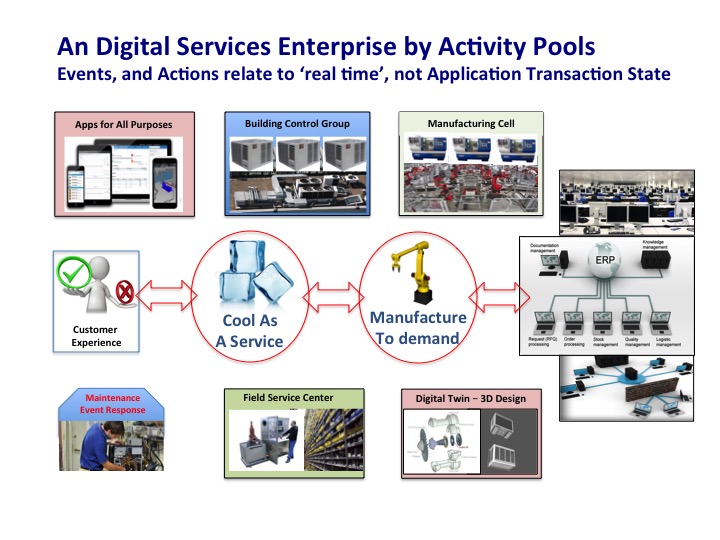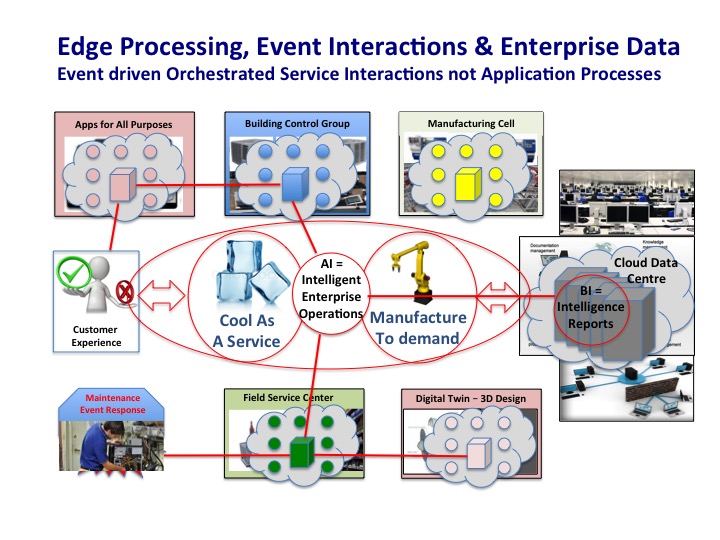Any definition of a Digital Business emphasizes the requirement to be marketplace responsive with Enterprise wide dynamic agility to optimize reactions to events, and opportunities. As business buyers and consumers both become adept at finding exactly what they want mass volume product and distribution becomes configurable software Products and Services. To increase revenues Enterprise have to become equally adept in the finding, and aligning the people, knowledge and operating assets to match.
The Digital Enterprise is driven by market ‘pull’, recognizing its assets in a granular model with orchestration of its capabilities and assets to meet the demands. In many ways this is a reversal of the focus on optimizing the ‘push’ model delivering a narrower range of more standardized products efficiently through defined streamlined processes. Revenue models based on Services can have wider consequences across the Enterprise in many areas, a point clarified latter.
Enterprise management is naturally concerned that this granular, orchestrated approach de-centralizes the Enterprise and risks its carefully constructed management governance. If the same controls were maintained this would be true, but the increased visibility of assets, the use of enhanced intelligence, and the use of OpEx financial management all increase management operational efficiency. The foundation of the Digital Business is built on, and maintained by, a similar change through deploying the new Technologies together to form what could be termed a ‘Business Infrastructure’.
A recognizable current change in Go to Market Business activities introduces increasing number of Cloud based Apps; Less recognized is the impact of distributed Apps requiring both localized Enterprise Edge Clouds in addition to large scale centralized Clouds. The addition of IoT provides both hyper connectivity internally, and externally, as well as the Digitization of physical objects/events supporting interactive ‘read and respond’ Smart Services. AI is just starting to make its commercial presence felt bringing near real-time optimization of these new Enterprise operations supplementing the historic reporting role of BI reporting.
Added with other changes in working practice through the adoption of Collaboration and Social Tools, Drag and Drop composition of localized processes by Line of Business managers, etc., to see the full impact in the role of Technology in enabling Enterprise Business activities. The existing Enterprise IT infrastructure was designed to support the stability of centralized Enterprise Applications. It can be cost reduced, and made more efficient, but it’s a challenge to believe it can operate in support of such a fundamental change in both Business and Technology use.
Business Technology is becoming the term used to describe the technologies of Apps, Clouds, IoT, and AI, deployed in an integrated combination to enable Digital Enterprises. A McKinsey outline of eight ways in which Business Technology trends are radically changing the capabilities of an Enterprise also serves to demonstrate how Business Technology differs from traditional IT. It logically follows that Business Infrastructure would be the logical term for the Infrastructure that supports Business Technology. For simplicity the term Business Infrastructure is used as broad and general reference, and for similar convenience the converged technologies of Clouds, Apps, AI, Services and (io)Things are referred to by the acronym CAAST.
The technologies of CAAST together provide the transformation in capabilities that create Digital Business. The market place, business activities, events, and assets are all represented as Digital data that an Enterprise can read and make the optimized responses in reply.
The Business advantage lies in the Enterprise becoming part of the real World able to directly relate marketplace events to internal operations. An Enterprise business model based on product selling does not have the extended relationship requirements that a Services business model requires. To successfully maintain a service revenue stream from the installed products requires IoT connectivity, with Cloud event processing, using a new approach to Business Infrastructure.
Consider the shift from Sales to Services against the example of a manufacturer of Air Conditioning units supplying the Building Management market, a notable early adopter of IoT based solutions. The design and manufacture of air conditioning units continues, but the revenue stream changes from selling the ownership of units to providing the market with ‘cooling’ as a Service. This business model shift introduces not only a whole range of activities necessary to keep air conditioners at work, but also changes to existing core activities.
The consequences of the shift from a Product Sales business model to a Services business are more than is perhaps immediately obvious. Selling an Air Conditioner as a product places the design and manufacturing focus on the sales price and on marketable competitive features. Continued product ownership with revenue from low cost operation changes the design and manufacturing emphasis towards increased reliability, durability and serviceability, with initial cost and additional features becoming of less importance.
The Air Conditioning unit naturally gains inbuilt IoT sensor connectivity to manage operational deployment, and provide data for predictive service maintenance, or to report a breakdown. Additionally the Digital Enterprise will need to use the full scope of the capabilities provided by CAAST to support new Enterprise wide range of Operational activities. The reorientation towards a Services model, as an example, may introduce Digital Twin models, and drive a new effort towards flexible and Lean Manufacturing. Market led Service-provisioning calls for tailoring the units produced to match the exact conditions of deployment, rather than batch production for stock or distribution.
 The organizational structure of a Digital Enterprise has to accommodate an increased number of functional activities able to operate in loose-coupled relationships driven by events. (As opposed to the tight coupled fixed relationship of a process driven Back Office Enterprise IT). The diagram below illustrates;
The organizational structure of a Digital Enterprise has to accommodate an increased number of functional activities able to operate in loose-coupled relationships driven by events. (As opposed to the tight coupled fixed relationship of a process driven Back Office Enterprise IT). The diagram below illustrates;

Those familiar with the organization of complex manufacturing will recognize the concept of ‘cells’, (used to allow different manufacturing tasks to achieve individual optimization, within a synchronized environment), but now expanded across the Digital Enterprise beyond manufacturing. The term Activity Pool is used to avoid confusion with the term Cell as defined in Industrial Automation.
Some obvious examples of major activities Pools are shown, note that this can include externalized, even shared, activity Pools such as the Building Management System, BMS, in which “cooling as a Service’ is deployed. A BMS is an integrated set of Services providing a Building with the cohesive infrastructure functions ranging from Heating, Cooling, Lighting, Plumbing, Security, etc. In a Smart Building these Services may come from several companies, but must operate 24/7 integrated as an independent Pool using localized interactions and processing. The Services providers will receive periodic historic data uploads on performance of their Services items, or event alarm triggers.
A Digital Enterprise will have deployed Services in many such external Activity Pools, as well as its own internal distinct Activity Pools. In each CAAST provides the Business Infrastructure of interactive connectivity within the Activity Pool supported by necessary local, or edge, based processing, and rules to identify event data streams to be forwarded to other Activity Pools.
Localized, or Edge processing, (sometimes called Fog Computing), reduces latency in responses, can increase security, as well as offering standalone reliability. In the Building Management example emergency situations, such as a fire, or flood, could cut external links, and are sensitive to latency in responses, would benefit from localized Cloud* processing. More common benefits are a reduction in the amount and cost of network traffic flooding across network links.
* Cloud technology should be recognized for its ability to provide ‘run anywhere on demand’ processing technology rather than thought of as being solely linked to massive data center consolidation of operations.
In the diagram below the Activity Pools are shown as Localized CAAST deployments allowing individual optimization, together with an Enterprise IT large scale Cloud, (probably from an external Cloud Service Provider). The red lines indicate the Activity Pools that would interact through an event data stream indicating Service Maintenance is required for an Air Conditioner located in the Building Control Group.

A further important addition is the use of AI to optimize the huge number of real-time events and circumstances that would be happening across the entirety of a Digital Enterprise. BI continues to provide the intelligent historic data analysis on which many of the Enterprise operating Rules will be based.
The Business and Technology models of a Digital Enterprise are effectively a single common model, deployed as a true loose-coupled Business Services architecture to provide optimization operational responses to real World events and circumstances. This is a radically different environment from Transactional IT, which has, and will continue to have, the task of providing stabile compliance in recording, maintaining and using the Enterprise Data records.
CAAST provides event driven orchestration of the Enterprise responses to the real World through the management of its Assets and capabilities. IT manages the integration of optimized processes to ensure the Enterprise tracks and maintains its compliant governance and core data.
The Business Infrastructure capable of supporting the inherent dynamic flexibility of the Digital Enterprise and its business model is crucially important as is the training and knowledge of how to assess its deployment in association with the Business model.
Part Two; The Technology and Business Infrastructure identifies three leading Technology vendors, outlining their vision and the capabilities each currently provides.
Cisco Converged Infrastructure a combination of Cisco Software Defined Networking and Cisco ASAP Hybrid Cloud Data Centre.
Dell Internet of Things Infrastructure citing the benefits of the merged product portfolios of Dell and EMC; whilst
HPE Composable Infrastructure aiming to support both traditional IT as well as the new demands of Business Technology.


